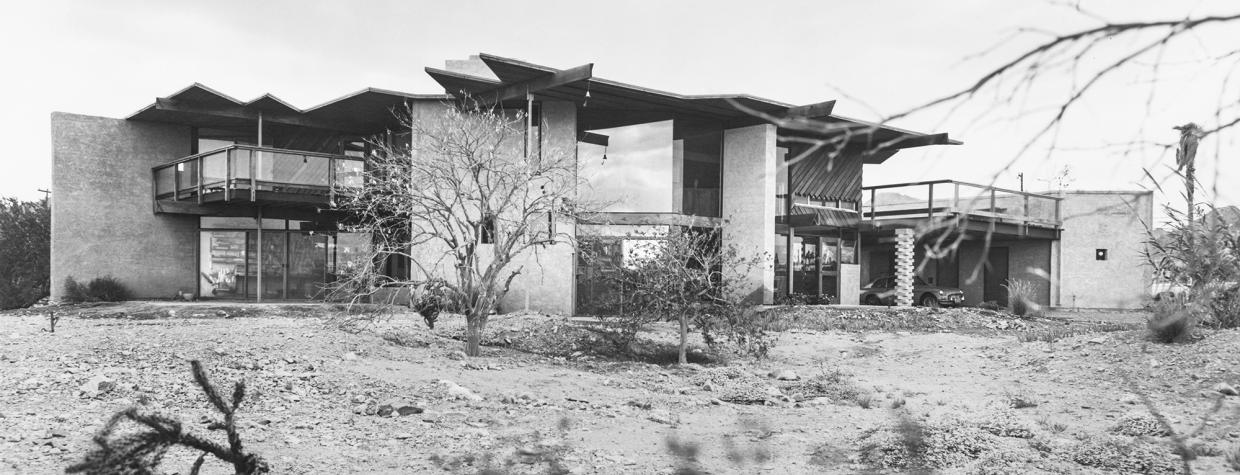In the early 2000s, architect Jeffrey Cook wrote a piece he hoped would be published in Arizona Highways. In it, he compared his Paradise Valley home, completed in 1970, to a nearby Frank Lloyd Wright house built 15 years earlier. Unlike the famously haughty Wright — who called his design, now known as the Boomer House, “the most interesting ever built” — Cook was muted in his descriptions of his own creation. But his pride was evident in the closing paragraph: “This design was the critical steppingstone to a research career that continues to explore the aesthetic opportunities in creative bioclimatic response.”
Cook’s piece never made it into Arizona Highways before the architect died of colon cancer in 2003. But his home, now known colloquially as the Cook House, was pivotal to more than his career. Today, both the house and its designer are cited as examples of how to build, and live, in the arid Southwest. As friend and colleague Klaus Dunker writes for Cook’s trust, “The house was unique and should be better known for its significance as the work of a gifted architect — and for the pioneering ideas it was built upon.”
Born in Nova Scotia, Canada, in 1934, Cook studied architecture at the University of Manitoba and New York’s Pratt Institute. He briefly taught at the latter school and in Canada before being hired by Arizona State University in 1962. There, he became an institution, teaching architecture design and theory courses for more than four decades.
Once at home in the desert, Cook developed a deep interest in bioclimatic design — that is, structures that work in harmony with the local climate. His own dwelling employed many of the principles he championed, particularly passive solar architecture, a concept now in widespread use. The house’s orientation kept it relatively pleasant in summer, while in winter, floor-to-ceiling windows captured much of the sun’s light, making the heating system mostly unnecessary. And the house’s thin, parasol-style roof offered ample shade while giving it a dramatic silhouette.
Sustainability was another of Cook’s passions, and in the piece he’d hoped to have published in this magazine, he noted his use of low-cost, low-impact and renewable materials, often locally sourced. In 1978, he further committed to sustainable design when he installed a solar hot water system. “Occasionally, perhaps twice a year, there will be a sequence of several cloudy days that eliminates all the hot water,” he wrote. “The solution is to stop washing dishes and to visit friends to bathe.”
Cook married author and artist Agnese Udinotti in 1967. They divorced in 1974, and their daughter, Alexis Stone Huff, recalls spending weekends and holidays at the Cook House. “It was kind of an open concept on the first floor, and you just didn’t see that back then,” she says. “The master bedroom was in a loft-type situation [above the living room], so when I got up early and wanted to watch cartoons, I had to sit very close to the TV so I could hear Bugs Bunny and not wake up my dad.”
The downstairs bedroom, Huff recalls, became something of a library for her father’s photographic slides and published material. Cook wrote several books and published more than 350 papers and other works. “He worked all the time,” Huff says. “He was always putting together lectures, and primarily, our trips were to places he was interested in architecturally.” Cook gave lectures in Mexico, India and other countries, and for a time, he advised the federal government on energy related matters.
Dunker writes that Cook wanted the house to be a model, not just for solar design but also for “an architectural approach that made daily life the center of concern.” In Huff’s telling, he succeeded. “My father liked to cook, and it had a great, large, open kitchen,” she says. “He taught me to cook there, and the design made it very easy.” Overall, she says, the Cook House was “very unique and very easy to live in.”
Photos and floor plans are all that survive of the house today — shortly after Cook’s death, his masterpiece was demolished in favor of a more conventional dwelling. But architects continue to celebrate Cook as a pioneer in bioclimatic design. His archives found a home at the ASU Library and inspired a 2016 exhibition at the university, and both his alma mater in Manitoba and the University of Toronto host an annual lecture in his name. And his self-funded legacy, the Jeffrey Cook Charitable Trust, provides grants to nonprofit organizations that apply his design principles to projects around the world.
“He was ahead of his time,” Huff says. “He was very aware of the planet and the impact we’re all having on it.” And while both her father and the house have been gone for nearly 20 years, both live on in her memory. “That house and him were one and the same,” she says. “If I were ever to build one, that’s the house I would build.”

